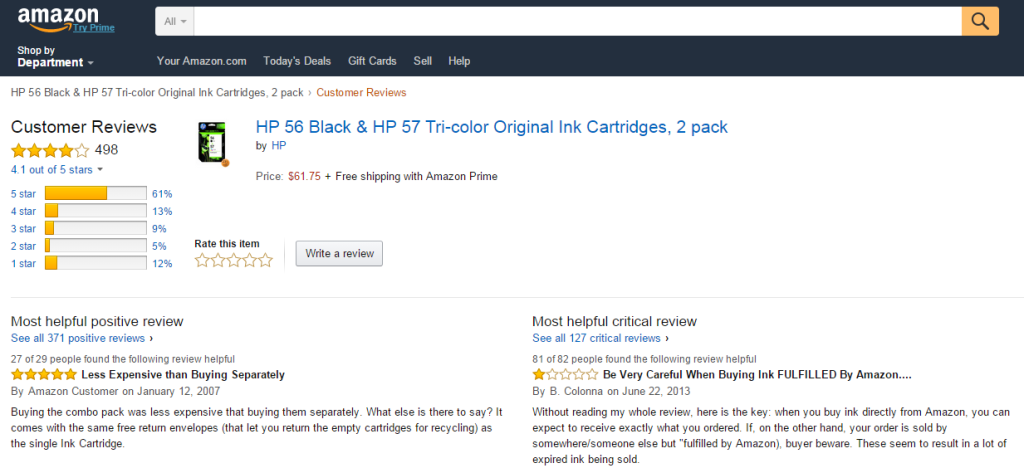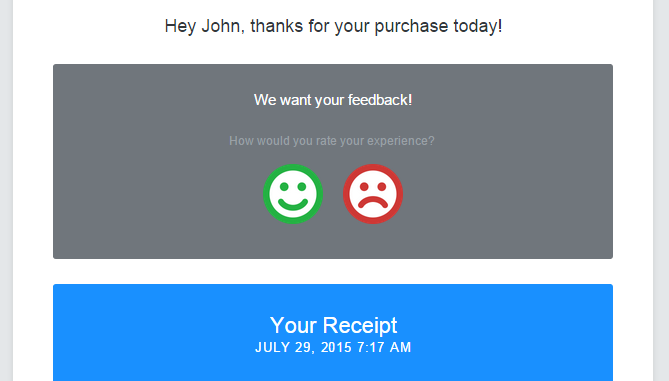How to Leverage Customer Feedback to Improve Your Ecommerce Store
In a crowded market, quality customer service is a critical differentiator among brands. According to Defaqto Research, “55% of consumers would pay more for a better customer experience.” More often than not, listening to shoppers has a direct and tangible impact on your bottom line.
In the October 2004 edition of the Journal of Marketing, professors Eugene W. Anderson and Claes Fornell of the University of Michigan Business School along with professor Sanal K. Mazvancheryl of Georgetown University published a landmark study that quantified the consequence of quality customer service on shareholder value. Among 200 businesses represented in the Fortune 500 across 40 industries, a 1% improvement in customer satisfaction increased a firm’s value by $275 million.
To improve loyalty, sales and retention rates among buyers, spend time actively seeking out and responding to customer feedback.
In this article, we will explain how store owners may turn user criticism and suggestions into profitable opportunities. Brands that spend more time listening develop a competitive advantage by re-engaging consumers, marketing their business and developing better products.
What customers know, want and need
Your customers know things that you don’t. Because they have specific needs and wants, they offer a unique perspective on how your product fulfills expectations and compares to the competition. As impartial buyers, they also know what the media, their peers and other reviewers have said about your business.
Develop an intimate understanding of what your customers know, want and need to establish a competitive edge that helps you improve how you do business and the value you offer to end consumers. Start by categorizing reasons for why your customers purchase your products. Shoppers buy things due to at least one of 20 primary motivations:
- Basic needs
- Convenience
- Replacement
- Scarcity
- Prestige
- Emotional vacuum
- Lower prices
- Great value
- Name recognition
- Fad or innovation
- Compulsory purchase
- Ego stroking
- Niche identity
- Peer pressure
- Goodwill
- Reciprocity
- Empathy
- Addiction
- Fear
- Indulgence
Appreciating exactly why people are willing to pay for your products is important. Often, consumers buy things to make their lives better, easier or more interesting. Certain benefits make a purchase more compelling, and customers can tell you whether or not to highlight those attributes more prominently. Similarly, customers can tell you specifically why they did not buy. Those reasons may include critical features your offerings are missing which are dealbreakers.
With a strong grasp on what your customers care about, you will be able to:
- Provide better customer service
- Introduce new products (or revive old ones that are still in-demand)
- Differentiate yourself from competitors
Overtime, you will learn to anticipate what your customers truly want. Armed with empathy towards buyers’ desires, you can build innovative products that fulfill all of your patrons’ needs. Stores that are responsive to consumer feedback sell items their shoppers will love, enabling them to transform casual customers into passionate purchasers.
Source high-impact feedback
A majority of your customers need a prompt before they are willing to share their feedback. In fact, a mere 4% of dissatisfied customers will voice their opinions while the remaining 96% withhold their criticism. Sadly, 91% will respond by never returning. To avoid such a high rate of visitor attrition, directly ask for their thoughts. Though the comments you receive from four percent of consumers is worth analyzing, it isn’t a representative sample. To expand the scope of your customer research, try these five tactics:
- Audit the reviews competitors receive — Take a look at the positive and negative criticisms customers share about your competitors. You may learn a lot from what buyers love and hate about other companies in your industry. This can help you brainstorm ideas for things to do, which shoppers may appreciate, and things not to do, which no one enjoys.
- Conduct surveys — Ask “Why?” to uncover consumers’ motivations for abandoning their shopping cart or completing a purchase. In each receipt, share a few post-purchase questions and leverage Follow-Up Emails. Interview one-time buyers and your most loyal customers. Dissect what makes different segments of your audience tick. The more you talk to them, the more information you will gather.
- Dive into your analytics — Spend time tracking what your users see and do on your website. Study their behaviors to identify pages that consistently engage them and ones that cause them to exit. This gives you an understanding of how visitors respond to the different content and offers on your site and how they organically progress through your shopping funnel. Soon, you may identify opportunities to plug leaks and keep serious shoppers engaged.
- Encourage user-generated content — Create contests to encourage more thoughtful user generated content. For example, Threadless hosts an open-ended design challenge for fans to submit their unique artwork to be printed on t-shirts. With the incentive to win cash, prizes and fame, more than 355,197 designs have been submitted and at least 6,814 have been printed.
- Track public conversations — Customers talk, and that is a good thing. Conduct thorough research on what people say about your brand and its offerings across discussion boards, forums and social media. Set Google Alerts or use other marketing platforms to monitor conversations that mention your brand. What you find may surprise you, and you can leverage that feedback to build a better digital store.
Summarize actionable takeaways
Though you may feel inclined to pursue every new idea that comes your way, resist the urge to react to every piece of feedback you receive. You may love what customers suggest but, like most store owners, you may be resource-limited. Before you put a plan into action, weigh the opportunity for each new idea and prioritize it based on available resources. A smart combination of immediate wins and long-term goals will keep you on your toes and allow you to consistently maintain momentum.
Here are three steps to building a powerful business case for doing anything:
- Quantify its impact. If adding a new feature to your latest wearable device will help 73% of your most loyal customers, then it is indeed worth prioritizing within the company’s list of to-dos.
- Measure its market opportunity. Will the development and promotion of a new product help the company generate $5 million in additional sales this year? Businesses that want to stay current and grow quickly must spend a majority of their time pursuing big ideas and even bigger opportunities.
- Get leadership buy-in. With your findings, propose new additions or changes at the next company-wide meeting. Stating how the implementation of these ideas affects your userbase and may increase the store’s overall revenue will surely capture your colleagues’ attention and, hopefully, their support.
Implement new changes
Start with low-hanging fruit — high-impact initiatives that are easy to do — and slowly work your way towards more labor- and resource-intensive projects that similarly drive meaningful results. Table suggestions that are low-impact and difficult to complete but do consciously squeeze in lightweight projects that drive positive ROI.
For example, minor changes you can make to your digital store based on customer feedback include:
- Updates to website copy
- Adding new images
- Inserting customer testimonials
- Including trust symbols
These tend to be more cosmetic but can significantly improve how audiences perceive your brand, interact with your website and decide to purchase or pass.
Moderate changes Ecommerce stores can implement are:
- Revising your returns policy
- Streamlining the checkout process
- Providing product recommendations
- Coupons, discounts, price changes, and free offers
Moving forward with any of these updates requires input and approval from other internal stakeholders, such as design, engineering and legal.
Heavy criticism from customers may suggest significant changes are in order such as:
- New product development
- Website facelift or redesign
- Video overviews
- Mobile responsiveness
As a result, digital shops should expect improvements in:
- Brand perception
- Consumer trust and credibility
- Conversion rate
- On-site engagement
- Word-of-mouth and referrals
Final thoughts
Businesses should bake superior customer service into their corporate culture. Companies that invest in analytics, conversations and surveys with consumers tend to grow faster, smarter and more profitably. First, establish a cadence for sourcing and processing feedback. Then, automate it.
Overtime, you will have access to more data that can help drive better product development and marketing. Shoppers who have an overwhelmingly positive experience with you will be more inclined to purchase more often and tell their friends.
How do you plan to incorporate consumer feedback into your customer service, marketing, product development, sales, and web design efforts?


